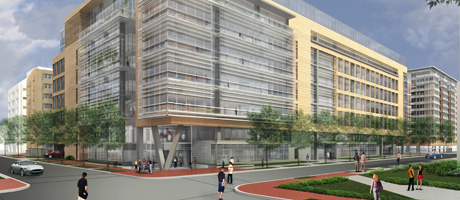In a major boost to the future of learning and the pursuit of discovery at GW, the university this year moved forward with plans to build a state-of-the-art facility for science and engineering.
Four years in the planning, the proposed Science and Engineering Complex won approval in October from the GW Board of Trustees, and in November the university filed an application for zoning approval from the D.C. Zoning Commission.
Board members felt the new building would “transform GW and help us strengthen our reputation as a premier research institution in the nation’s capital,” Board Chairman W. Russell Ramsey, B.B.A. ‘81, said after the decision. “It will be a powerful magnet for world-class faculty and students.”
The building on the Foggy Bottom Campus, which is slated for completion in late 2014, would nearly double the space available at GW for science and engineering. It also would bring under one roof a network of academic departments—from biology and physics, to hominid paleobiology, computer science and civil and environmental engineering—that currently are spread across a dozen buildings on campus.
“The board’s decision to build the Science and Engineering Complex marks an important milestone in the development of George Washington into a world-class research university,” said GW President Steven Knapp, following the board’s approval. “This crucial addition to our academic facilities will open countless new opportunities for learning and research, to the benefit of students and faculty in a very wide range of fields.”
Pending final D.C. Zoning Commission approval, project construction is expected to begin in 2011, after the university’s commencement in May.
The building’s eight stories above grade and six below—four of which would be for parking—would provide approximately 400,000 square feet of space above grade and yield 290,000 square feet for teaching and research laboratories, as well as offices and support spaces, for GW’s Columbian College of Arts and Sciences and the School of Engineering and Applied Science.
The School of Medicine and Health Sciences, among other schools and departments, also would be involved in research there.
The design of the building targets silver-level certification from the U.S. Green Building Council’s Leadership in Energy and Environmental Design (LEED) rating system. Plans call for a variety of sustainable elements, including dedicated parking spaces for recharging electric cars, a green roof, a cistern to collect storm water run-off for reuse, and strategically located sunshades on the exterior to reduce energy demands.
The building is estimated to cost $275 million, and will be funded primarily with lease payments from a mixed-use building under construction on Square 54 (the site of the old GW Hospital, and across the street from the new one), indirect cost reimbursement from grants and contracts supporting faculty research, and philanthropic gifts.


